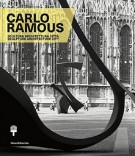Carlo Ramous Scultura Architettura Città Sculpture Architecture City
| Author(s) | Fulvio Irace, Luca Pietro Nicoletti | ||
| Editor | Silvana Editoriale | Place | Milano |
| Year | 2017 | Pages | 304 |
| Measure | 24x29 (cm) | Illustration | 110 ill. a colori e b/n n.t. - colors and b/w ills |
| Binding | bross. ill. a colori con alette - paperback | Conservazione | Nuovo - New |
| Language | Italiano/Inglese - Italian/English text | Weight | 2000 (gr) |
| ISBN | 883663768X | EAN-13 | 9788836637683 |
not available
Milano, Triennale, 12 luglio - 17 settembre 2017.
Carlo Ramous (1926-2003), protagonista trascurato della scultura italiana del secondo Novecento, ha attraversato in pieno le fasi cruciali dell’arte moderna approdando, all’inizio degli anni settanta, alla dimensione dell’opera d’arte ambientale. Dopo il restauro di un significativo nucleo di grandi sculture, in parte collocate in luoghi pubblici milanesi, il volume ripropone il percorso dell’artista nella sua ampiezza e problematicità, mostrando tutti i passaggi della sua evoluzione stilistica e poetica.
Fin da giovanissimo Ramous strinse un proficuo sodalizio con architetti e progettisti che gli consentì di realizzare, già nella seconda metà degli anni cinquanta, alcuni significativi interventi scultorei applicati all’architettura religiosa e industriale: le facciate delle chiese alla periferia di Milano e gli stabilimenti di nuova costruzione in Italia e all’estero divennero il campo di grandi decorazioni istoriate od ornamentali in tutt’uno con l’edificio. È negli anni settanta, però, che l’artista giunse a una articolata concezione ambientale della scultura, che abbandona le precedenti ricerche sul segno e sulla materia per dare respiro a forme geometriche dai profili nitidi che si articolano nello spazio con ardito calcolo degli equilibri. Riflettendo sui volumi plastici secondo idee già futuriste, Ramous aveva da subito concepito la scultura come forma pronta a staccarsi da terra per librarsi nello spazio. Come scrisse Giuseppe Marchiori nel 1973, “i netti profili delle scultura di Ramous […] devono disegnarsi in uno spazio ampio: per esempio nello spazio del ‘paesaggio’ urbano. Esiste un singolare rapporto tra queste ‘sigle’ monumentali e lo sfondo anonimo delle periferie cittadine”.
Carlo Ramous (1926–2003), neglected protagonist of Italian sculpture of the second half of the 20th century, with his work passed through the main stages of modern art reaching dimensions typical of Land Art at the beginning of the Seventies. After the restoration of a meaningful group of big sculptures, some of which are placed in public spaces in Milan, this volume presents Ramous’s path in its extent and complexity, clarifying all of the steps of his stylistic evolution.
From the beginning he had created artistic relationships with architects and designers which lead him to the creation of significant sculptural works applied on religious and industrial buildings in the mid Fifties. The façades of churches in the outskirts of Milan and factories in Italy and abroad became spaces for big figurative or ornamental decorations which melded with the building itself. However, it was in the Seventies that Ramous reached an articulated conception of sculpture as Land Art. At that time he abandoned his previous experimentations with lines and material to reach the creation of geometrical forms with clear edges which articulate themselves in the space that surrounds them in a balanced form. Thinking about plastic volumes, which had already interested the Futurists, Ramous conceived sculptures as shapes ready to detach from the ground and soar to the sky. As Giuseppe Marchiori wrote in 1973, “the clear edges of Ramous’s sculptures […] need to stand out in a wide space, for example in the urban ‘landscape’. There is a unique relationship between the monumental ‘signs’ and the anonymous backgrounds of the suburbs”. (T-CA)
Recommended books...





